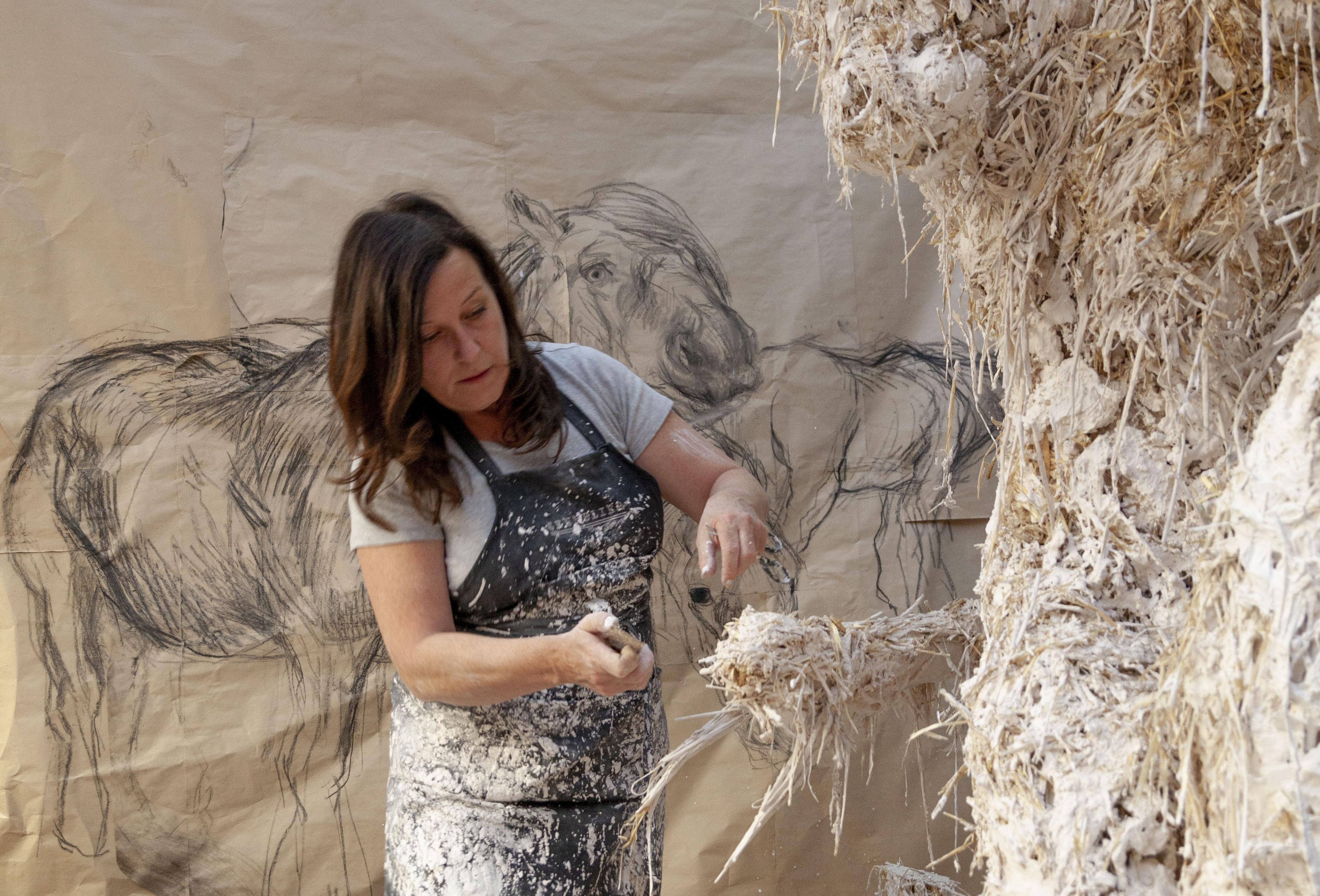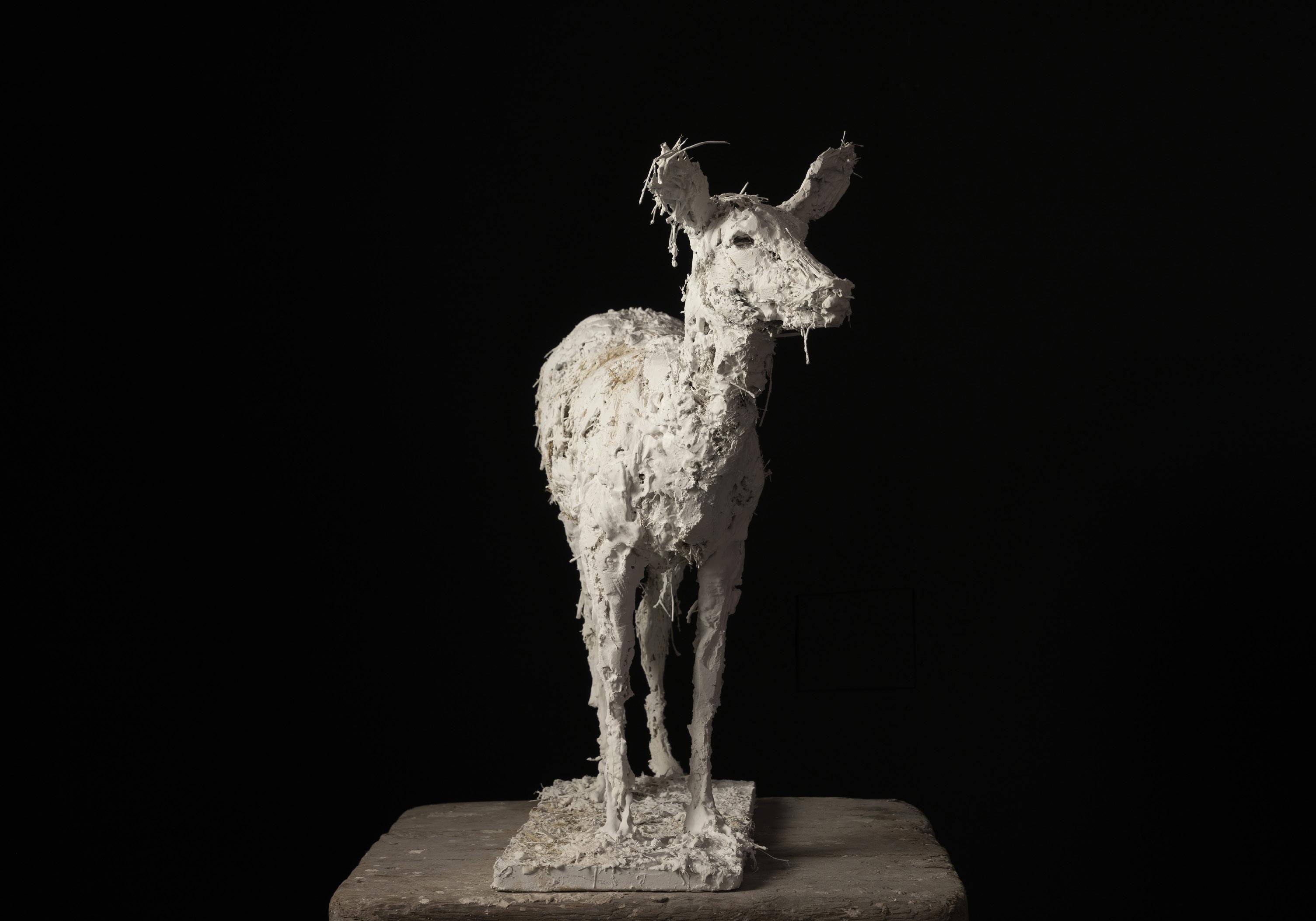NICOLA HICKS



Marks on the Wall presents a selection of straw and plaster sculptures, some with two-dimensional backdrops, as well as a selection of charcoal drawings, depicting gallant, humanized animals, both familiar and mythic. Hicks captures the transcendental power of beings with an extraordinary intensity that eclipses mere visual fact or scientific anatomy. Elephants, bears, swans, dogs, or Minotaurs, Hicks’ art radiates an archaic energy and is far more a spiritual study of life- human, animal or otherwise- than a formal study of animals.
from her chair to get a closer look at the mark, the simplest solution to discerning what the mark was because she didn’t know whether the knowledge she would gain would bring her any contentment, and therefore was unsure if it was worth knowing. The narrator is critical of knowledge for knowledge’s sake, as she considers the ways in which society has used knowledge to order the world, like Whitaker’s Table of Precedency, has created only hierarchies and questions that are both exhausting and vexing. These so-called concretes cannot grasp the true messiness of this world.
The exhibition takes its title from Virginia Woolf’s "The Mark on the Wall" (see page 118), a 1917 short story about the epistemological musings of a woman who notices a dark spot on her wall, and winds between ideas of what the mark could be and the nature of knowledge. “How readily our thoughts swarm upon a new object, lifting it a little way, as ants carry a blade of straw so feverishly, and then leave it."
“How readily our thoughts swarm upon a new object, lifting it a little way, as ants carry a blade of straw so feverishly, and then leave it....”
Though she considers it, she never actually gets up
The unnamed narrator declares that “No, no, nothing is proved, nothing is known. And if I were to get up at this very moment and ascertain that the mark on the
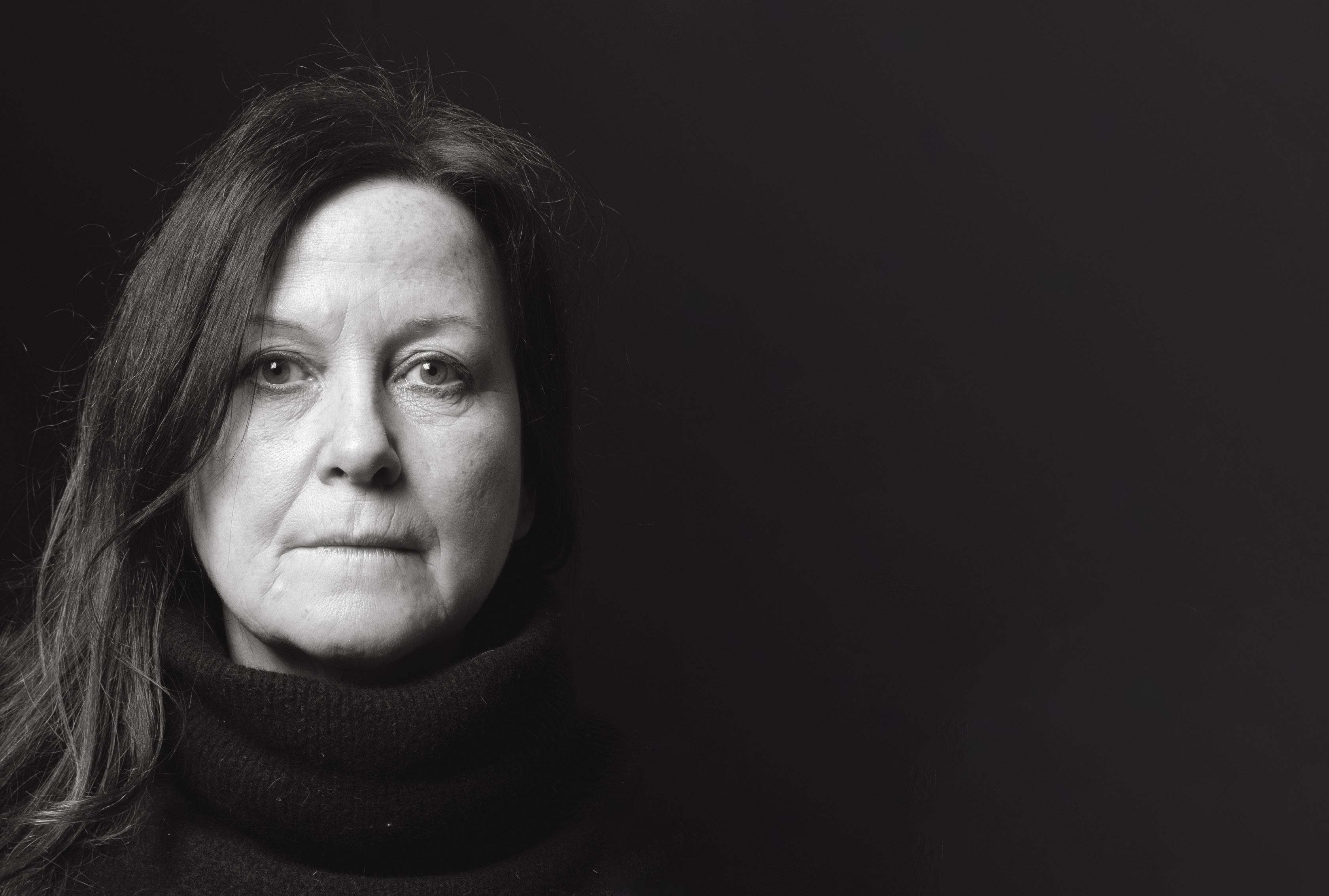
wall is really… what should I gain?–Knowledge? Matter for further speculation? I can think sitting still as well as standing up. And what is knowledge? What are our learned men save the descendants of witches and hermits who crouched in caves and in woods brewing herbs, interrogating shrew-mice and writing down the language of the stars? And the less we honour them as our superstitions dwindle and our respect for beauty and health of mind increases.... Yes, one could imagine a very pleasant world. A quiet, spacious world, with the flowers so red and blue in the open fields. A world without professors or specialists or housekeepers with the profiles of policemen, a world which one could slice with one's thought as a fish slices the water with his fin, grazing the stems of the water-lilies, hanging suspended over nests of white sea eggs.... How peaceful it is down here, rooted in the centre of the world and gazing up through the grey waters, with their sudden gleams of light, and their reflections–if it were not for Whitaker's Almanack...”
thinking. Having not ever taken an anatomy class, Hicks has never aimed to make "perfect," scientifically-correct reproductions of nature. Rather, Hicks, in feverish acts of unselfconscious intuition, first internalizes and then decisively tackles the essential essence of the animals she captures. Hicks not only studies animals by looking, but also by feeling. She explores what it feels like to be- what it means to be- each animal: she internalizes the slinky, tentative glide of a fox, the sagging weight and deliberate gait of an elephant and the aloof yet confident bearing of a family dog. The resulting work embraces the messiness and the complicated nature of beings.
To capture this nature, Hicks’ artistic practice has long prioritized methods for lessening the gap between thought and making. Her large-scale drawings, are constructed from quickly tearing off her archival Welsh paper, which "comes on huge roles that give a luxurious sense endless supply and possibilities."
Hicks creates her works through a similar line of
Drawing with charcoal, chalk, and pastel, she is able to swiftly, subconsciously and confidently unleash the
figure bursting through her imagination.
start again on a piece or get pulled back into the same mistakes." Due to the delicate nature of her materials, the final sculpture is often cast in bronze, though it can also remain permanently in its original medium.
Some parts of these animals are left unfinished, as Hicks is unconcerned with those elements not integral to the figure’s essence. She creates her three-dimensional work in a similar nature through a unique sculpting process that involves plaster and straw. There is straw strewn about Hick’s studio (she has always surrounded herself with animals), which she continually gathers and mixes with plaster to erect a figure, one handful of the plaster and straw mixture at a time. Hicks has remarked, "If I'm working on a piece and it starts to look terribly finished and a bit dead, then I'll chuck it in the bin and re-start it again very fast. At least one in five goes into the bin. You must
These sculptures appear as if walking up out of the earth from which they came, powerful, fleshly and noble, despite their marginally abstracted bodies, simultaneously obscured and fabricated by straw. The cyclical materiality of Hicks' work is intentional. “I like earth. I like rust. I like stuff. And very often that's the element I want to bring back into the sculpture."
Marks on the Wall showcases select sculptures with backdrops drawn by Hicks, giving some of her latest beings their own environs and context. Although the figures exist within these drawn environments, they also dominate them, elevating the beings by emphasizing both their autonomy and their individuality within the
"If I'm working on a piece and it starts to look terriblyfinishedandabitdead,thenI'llchuck it in the bin and re-start it again very fast… You must start again on a piece or get pulled back into the same mistakes."
“I like earth. I like rust. I like stuff.”
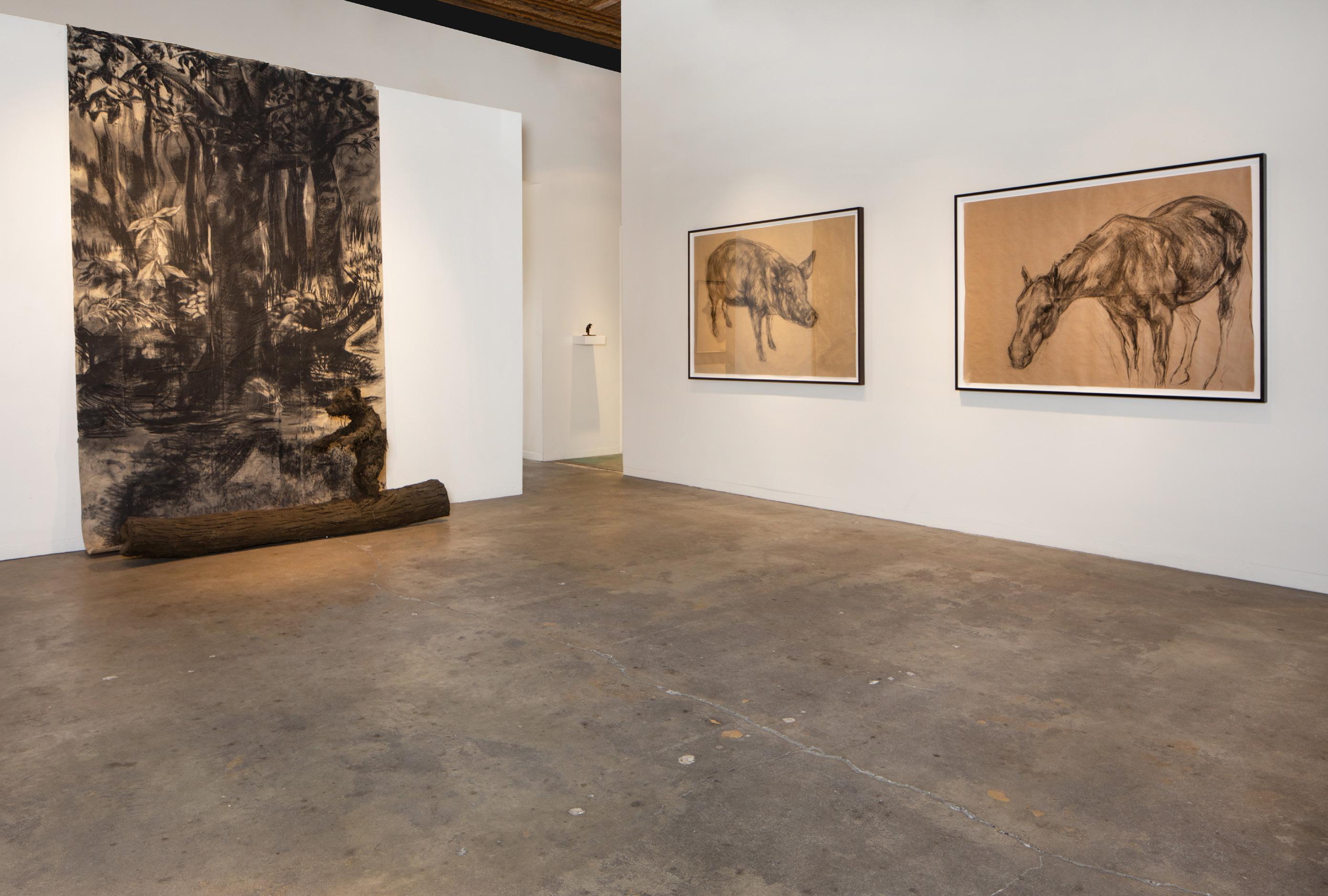
vast nature they inhabit.
Avoiding the romantic, descriptive, or simply anthropomorphic depictions of animals that have dominated the figurative animalier art of the past, Hicks embraces the messiness of animals, humans and everything in between. Her practice is rooted in her empathy for the creatures she creates, resulting in works that elicit a visceral response in addition to simple visual recognition. Hicks is far less interested in her work closely resembling a particular animal; rather, she wants the figure to be that animal in essence and spirit.
herself wind through her own musings rather than search for a concrete answer to the question she began with, Hicks primary concern is her emotional response to the animal she is capturing. “I’ve never wanted to make anatomically correct models and yet I do want you to sense that [a sculpture] is a living, breathing, soft being- a real person… It’s often surprising how things don’t actually look like how we imagine them to look. I am fascinated by how we filter images and information through our brains and how it comes out. It’s the emotional response to something that interests me most and that’s what I’ll make the sculpture about. It’s about the smell and the feel of a horse or person rather than the correct anatomical representation. And it’s very much my personal response.”
Like the narrator in The Mark on the Wall , who chooses to continue looking at the mark on her own terms, letting
Hicks’ emotional response to the figures she is creating is just as true as any anatomical representation, and says just as much, if not more, about the figure and its nature. Hicks’ works give the creatures she is inspired by a depth and humanity that science alone cannot lend. Bison seems as if it is trudging through snow, its
“There can be something about a single line or a simple gesture that says more about a feeling or a body than you could plan in a million years.”
head slightly raised as if it has just heard the snap of a twig. In looking at the work, one can feel the weight of the bison’s heavy shoulders and the crane of its neck under that weight. Although much of the figure’s detail is veiled by the straw, the details left out or concealed are not integral to the work. In Night Garden , the feline’s stance is familiar, and the quietude of the cat's measured, silent steps is visceral.
could find in the wild. Relic No. 2 , a mythic minotaur, is solemn if not forlorn; its horns have been shaved down- a common safety measure done by those working with cattle. These details create figures with more depth, understanding and recognition as part of Hicks’ spiritual study of beings. This study is rooted in looking and feeling, powered by Hicks’ role as a ”watchful alien.”
“It’s about the smell and the feel of a horse or person rather than the correct anatomical representation.Andit’sverymuchmypersonal response.”
Best known for creating heroic, humanized animals and mythic, beast-like humans, Hicks portrays other animals in the exhibition with more human attributes.
Journey is more reminiscent of a child boldly balancing while a parents’ eyes are turned, than any bear one
Hicks says, “I do my best, all day, every day, to be watchful and open. I lie in bed and look at the ceiling and follow different patterns and shapes in the blotches. I fiddle with shapes and ideas all the time. I draw every day and would go mad if I wasn’t allowed to… It all goes back to being the watchful alien. I really do believe that ninety percent of skill in art is to do with recognition, in
“I’ve never wanted to make anatomically correctmodelsandyetIdowantyoutosense that [a sculpture] is a living, breathing, soft being- a real person… It’s often surprising how things don’t actually look like how we imagine them to look.”
recognizing the moment and in knowing when to stop. There can be something about a single line or a simple gesture that says more about a feeling or a body than you could plan in a million years.”
Nicola Hicks was born in London in 1960 and studied at Chelsea School of Art and the Royal College of Art. The daughter of two artists, Hicks, grew up producing art. She became an established presence among the artists of her generation at the young age of 25. In 1995, Hicks was awarded an MBE for her contribution to the visual arts. Hicks’ sculptures and drawings have been presented in numerous international museums and galleries.
Monastery, Langenbruck, Switzerland and in Battersea Park, London. Solo exhibitions include Flowers Gallery, London and New York City; St Paul’s Cathedral, London; Yale Center for British Art, New Haven, United States; and Tayloe Piggott Gallery, Jackson Hole, United States, among others. Hicks’ work was included in The Universal Addressability of Dumb Things, curated by Mark Leckey, as part of the Hayward Touring series at venues across the UK during 2013. Hicks’ work can be found in the collections of the Tate Gallery in London, the Hakone Open Air Museum in Kanagawa, Japan, and the Castle Museum in Norwich, Contemporary Art Society, Government Art Collection, and the National Museum of Wildlife Art, among many others. In 2023, Hicks was elected a fellow of the Royal Society of Sculptors. Hicks lives and works in London.
Hicks has completed several public commissions, including large-scale sculptures at Schoenthal
“I really do believe that ninety percent of skill in art is to do with recognition, in recognizing the moment and in knowing when to stop.“

“I like earth. I like rust. I like stuff. And very often that's the element I want to bring back into the sculpture."
- Nicola Hicks
"I see everything in terms of three dimensions. even the drawings, and I don't think it'd matter which I end up doing because it's almost the same exercise....the concern is the same.I think I might ultimately get frustrated if I can't make anything in the round; I love that magical feeling of having something evolve at your finger tips, that you are making something live that hasn't lived before."
- Nicola Hicks


Bronze, edition 2/3
41 x 38 x 26 inches

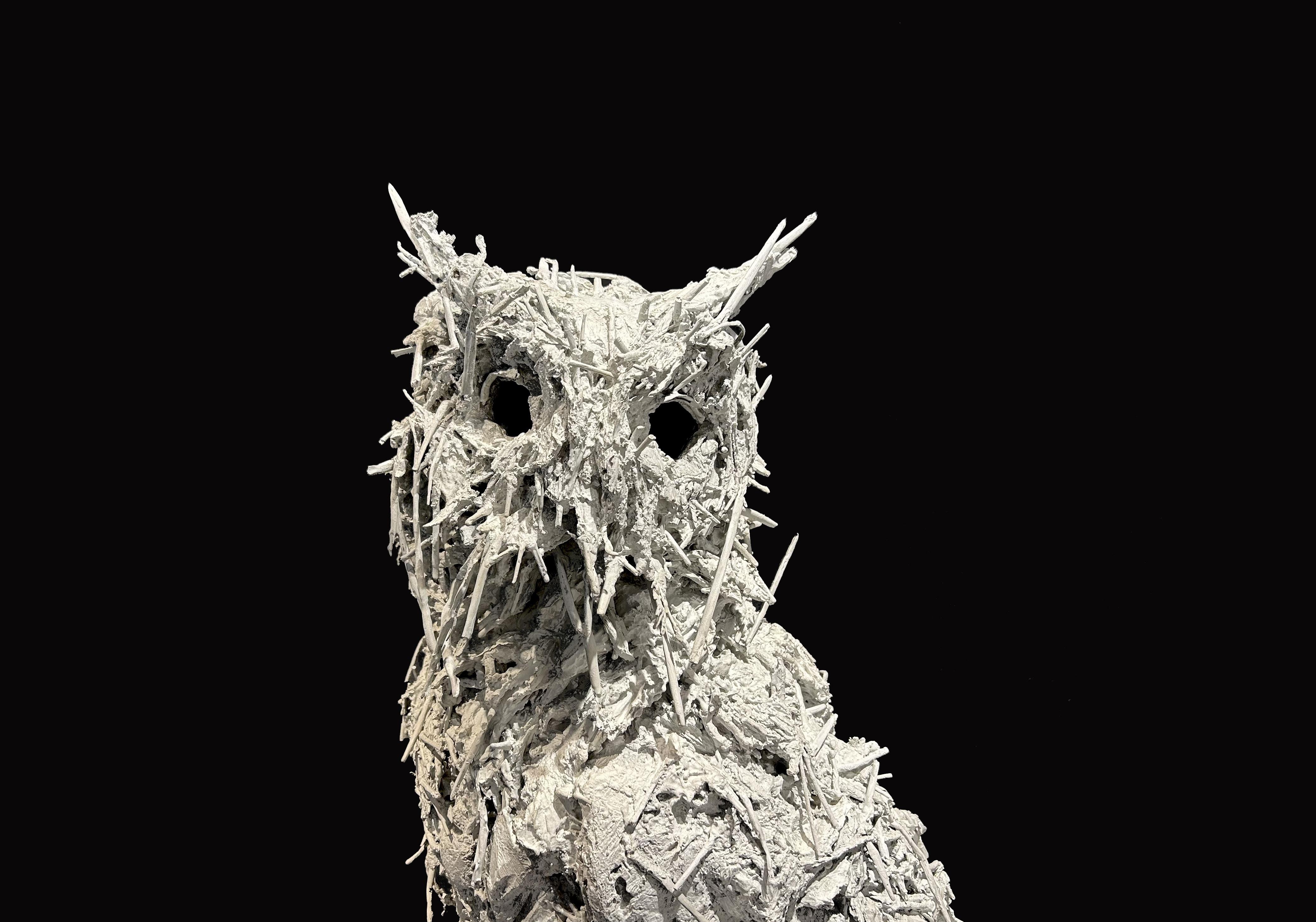




 JOURNEY , 2023
Plaster and straw
JOURNEY , 2023
Plaster and straw
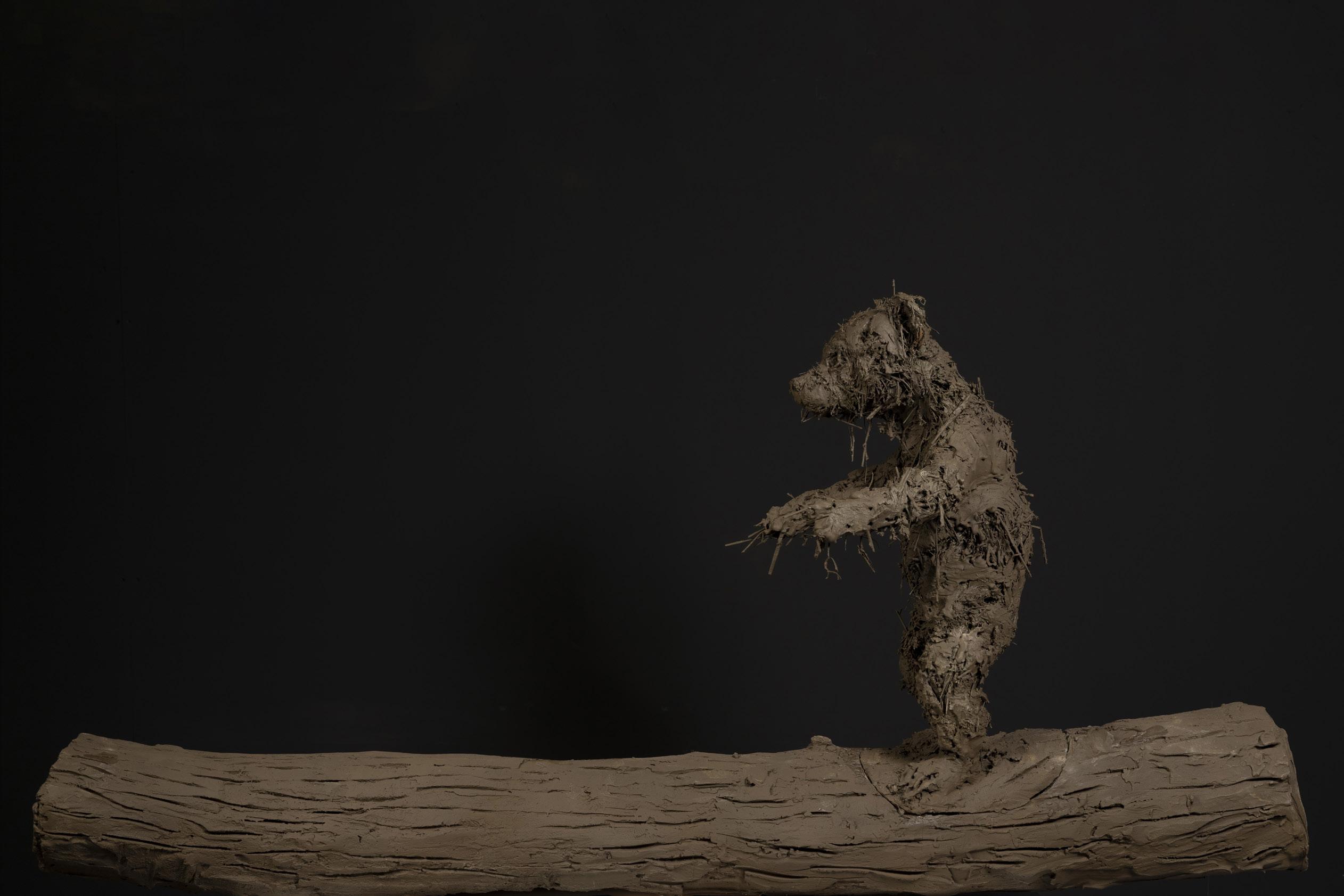
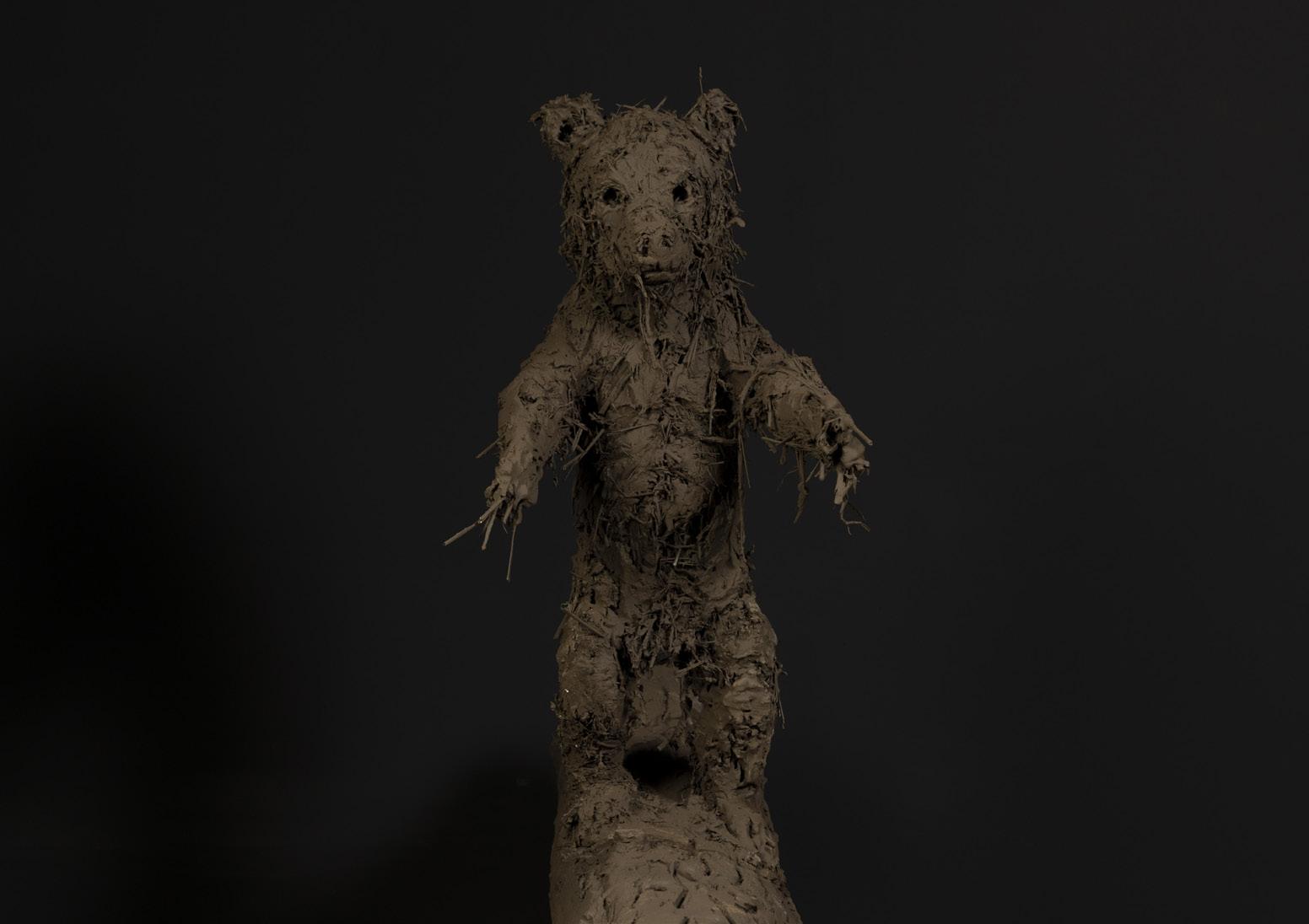



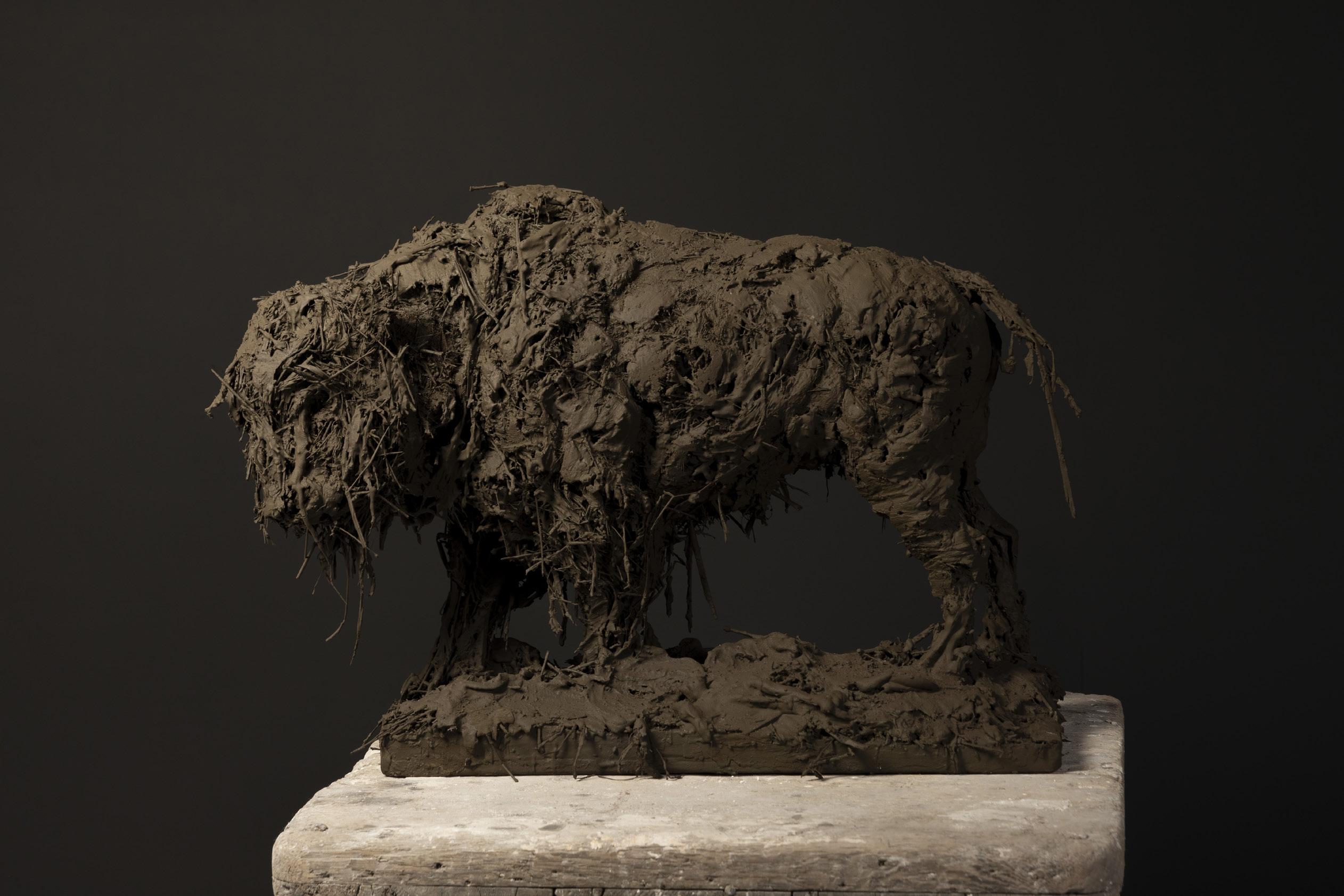
"If I'm working on a piece and it starts to look terribly finished and a bit dead, then I'll chuck it in the bin and re-start it again very fast. At least one in five goes into the bin. You must start again on a piece or get pulled back into the same mistakes."
- Nicola Hicks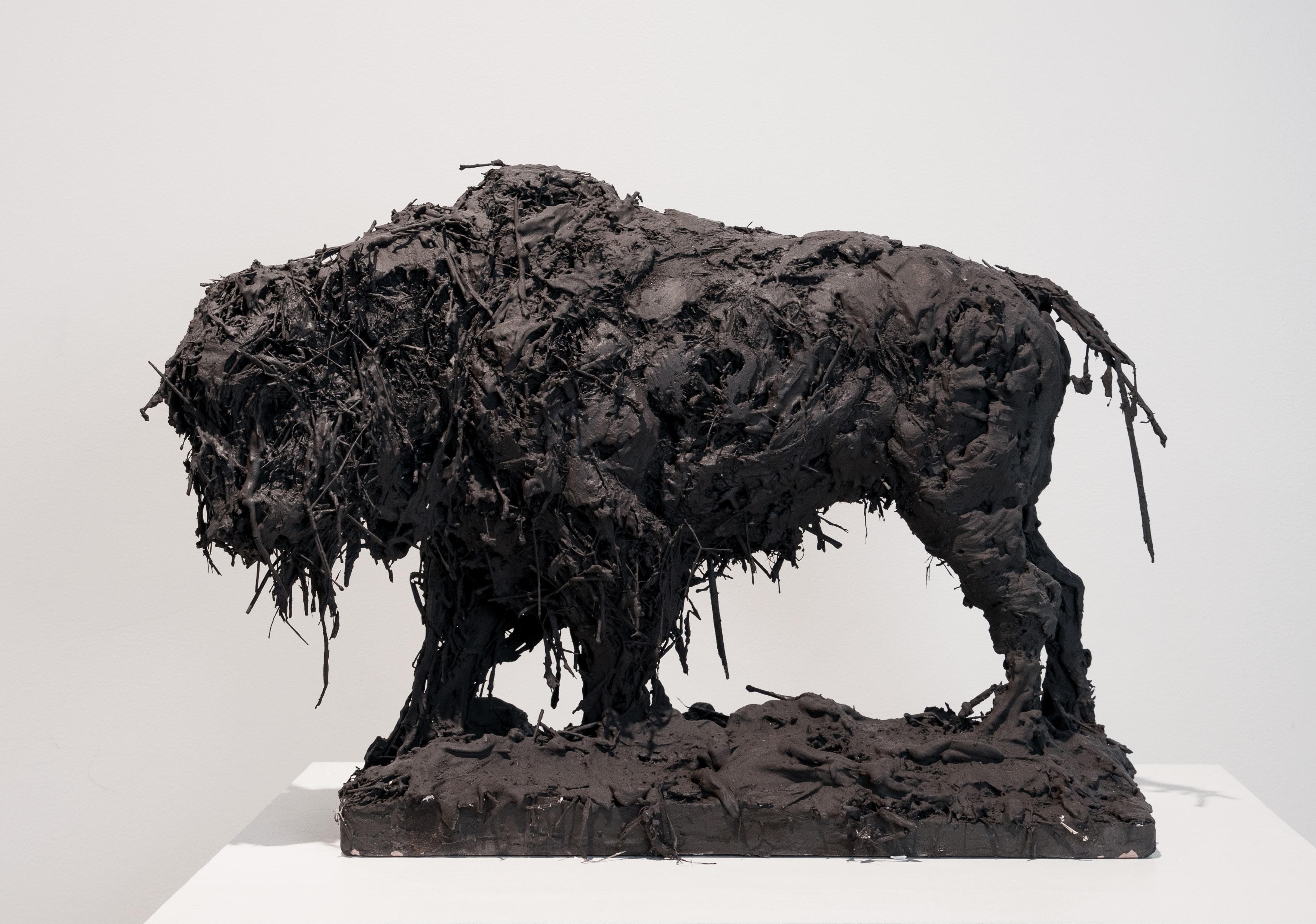
NIGHT GARDEN , 2023
Plaster and straw
48 x 25 x 42 inches


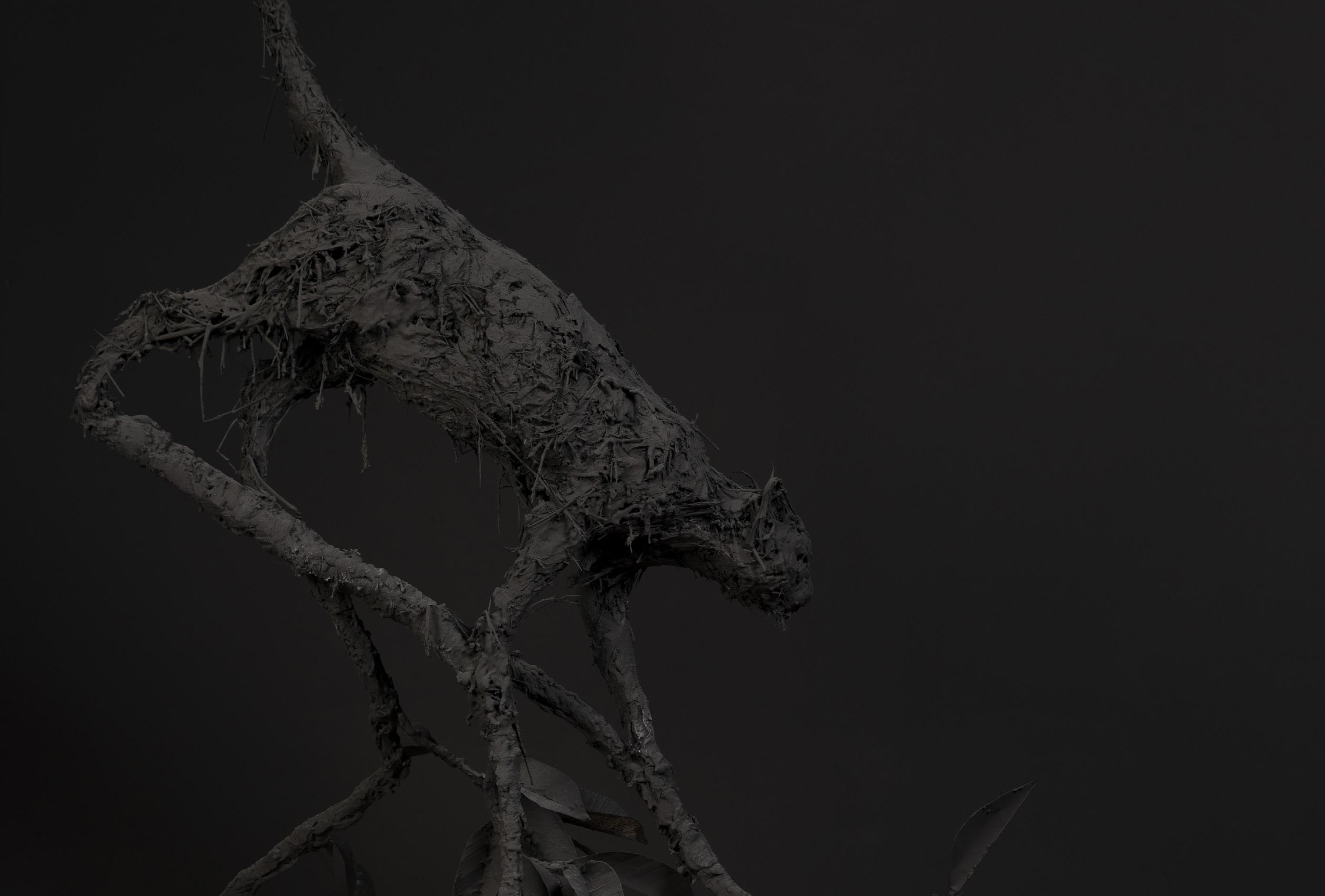
“How readily our thoughts swarm upon a new object, lifting it a little way, as ants carry a blade of straw so feverishly, and then leave it....”
- Virginia Woolf, "The Mark on the Wall"

RELIC NO. 2 , 2023
Plaster and straw
29 x 27 x 28 inches

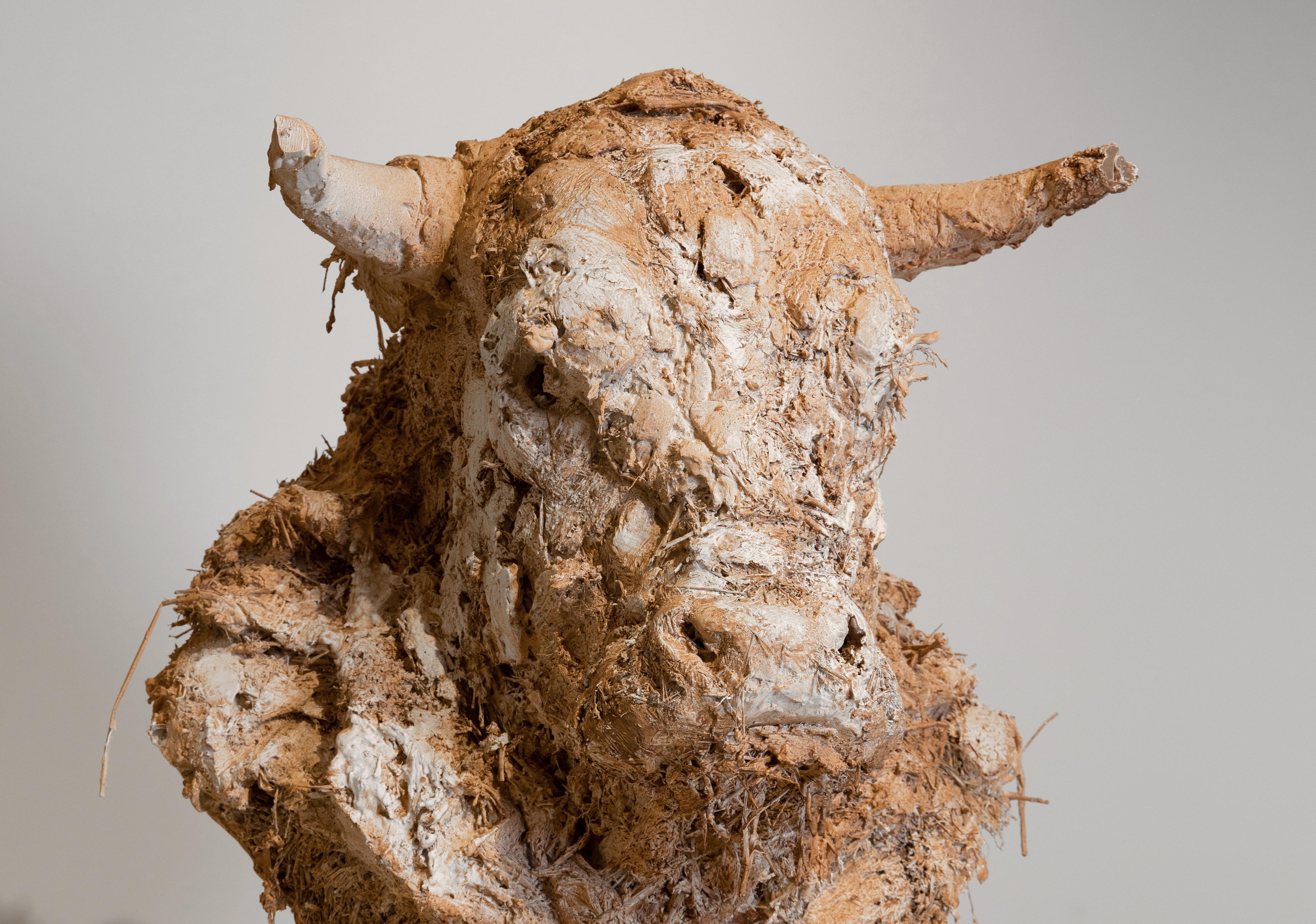

Bronze, edition 1/6
8 x 16 1/2 x 5 1/2 inches


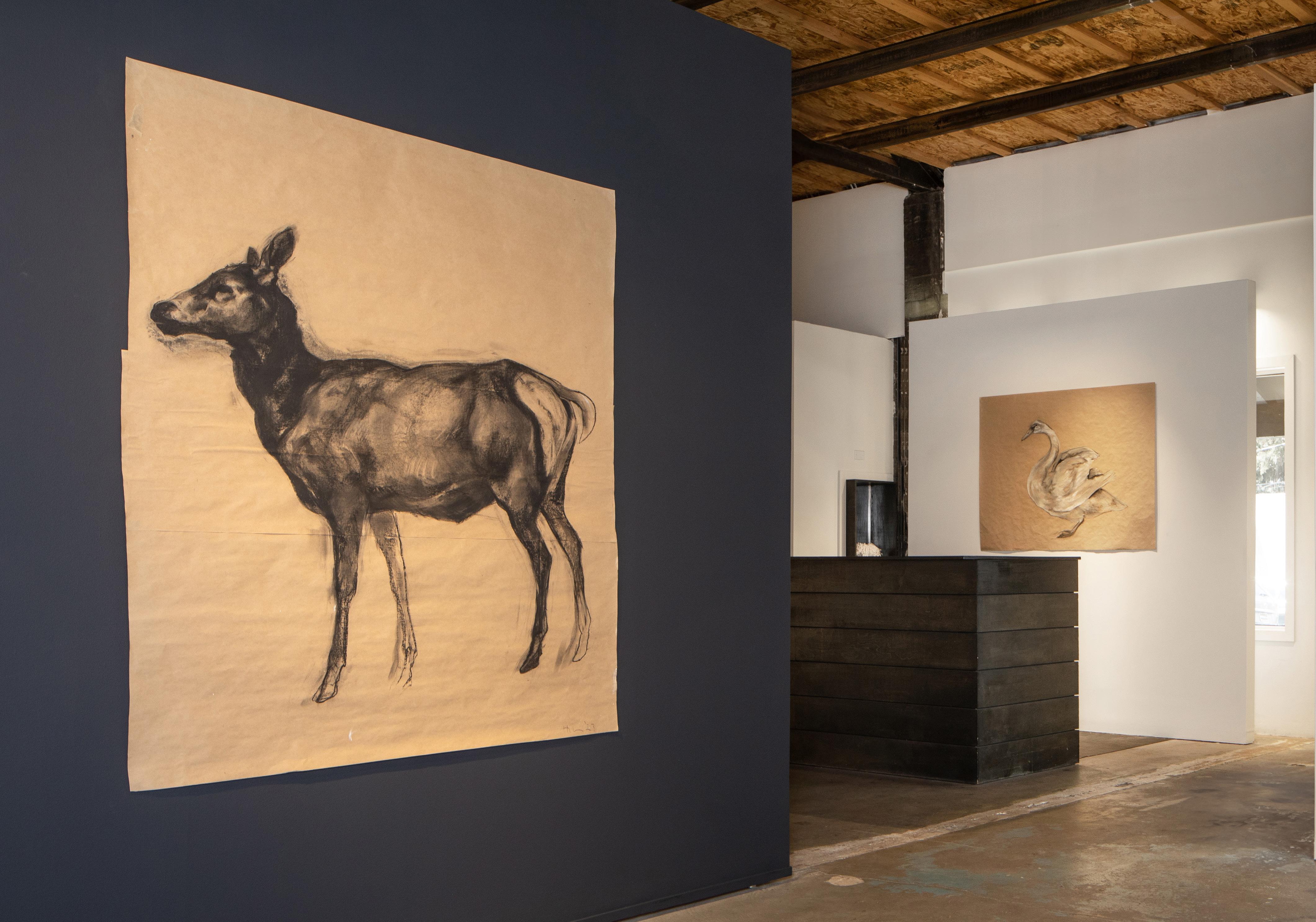

Charcoal and pencil on paper
69 x 58 1/2 inches
ELK , 2023



67 x 45 inches

Charcoal and pencil on paper
59 x 45 inches

CINNAMON BEAR , 2023
Charcoal and pencil on paper
45 x 59 inches
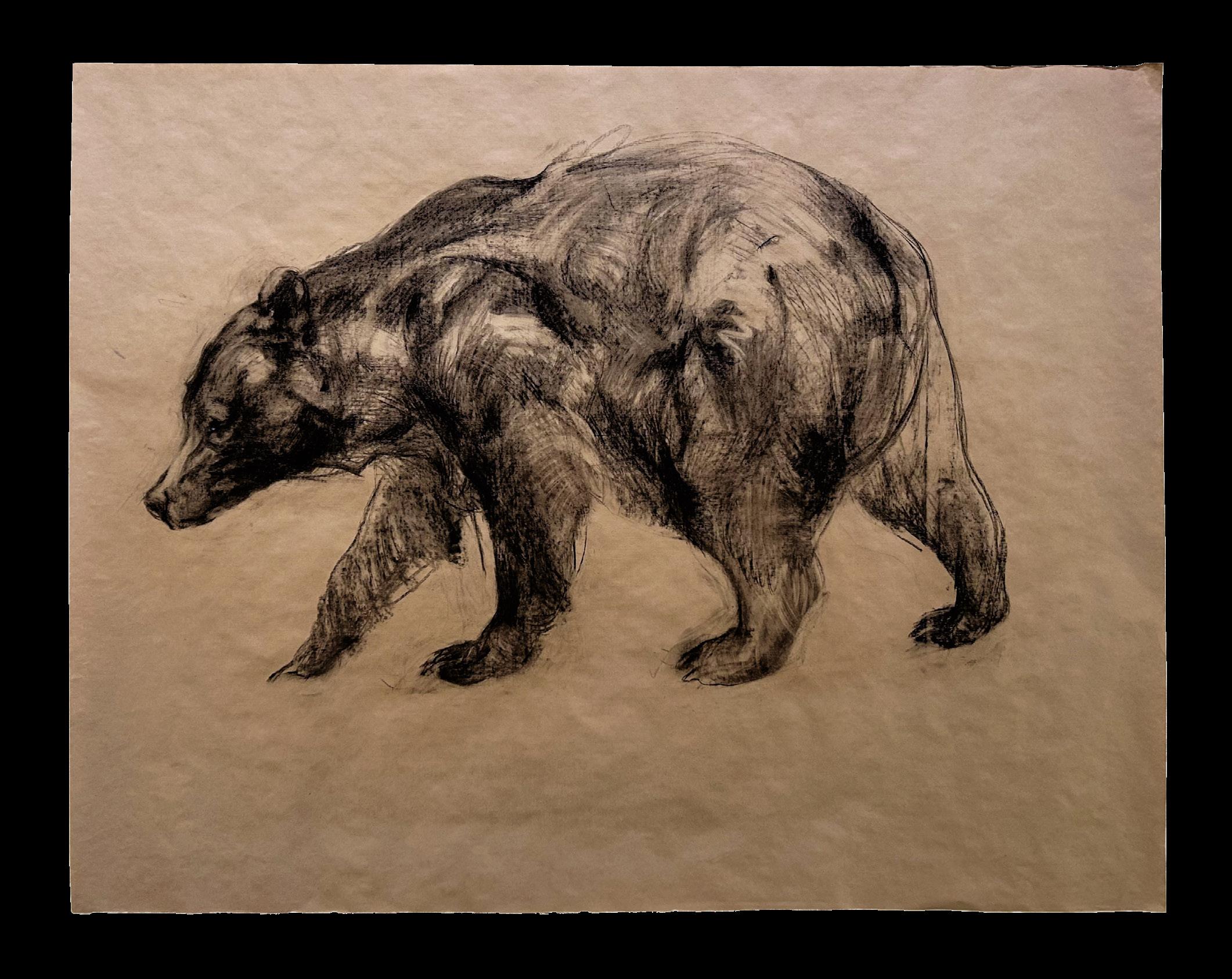
72 x 50 inches

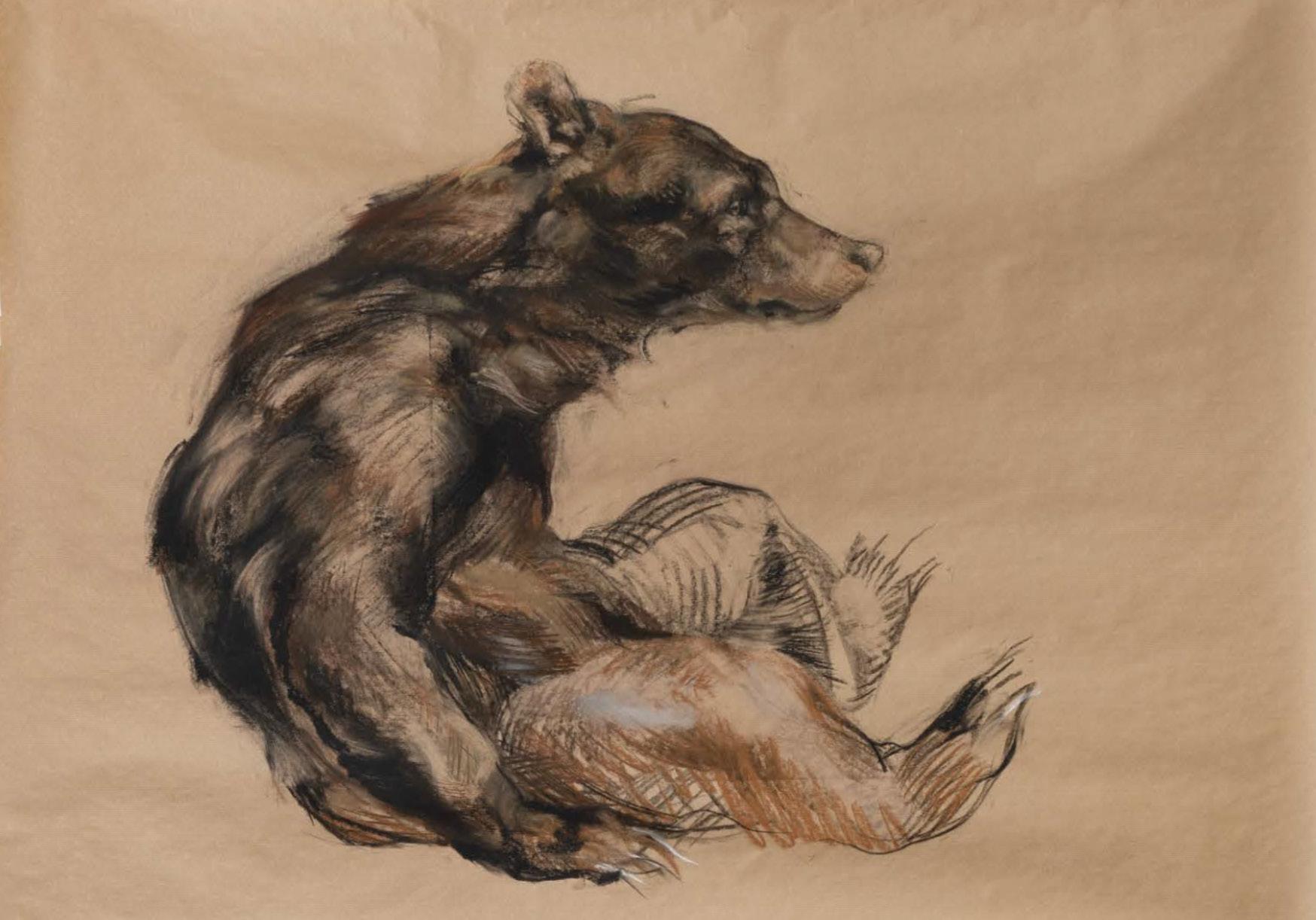
SAYING HELLO , 2023
Charcoal and pencil on paper
80 x 132 inches

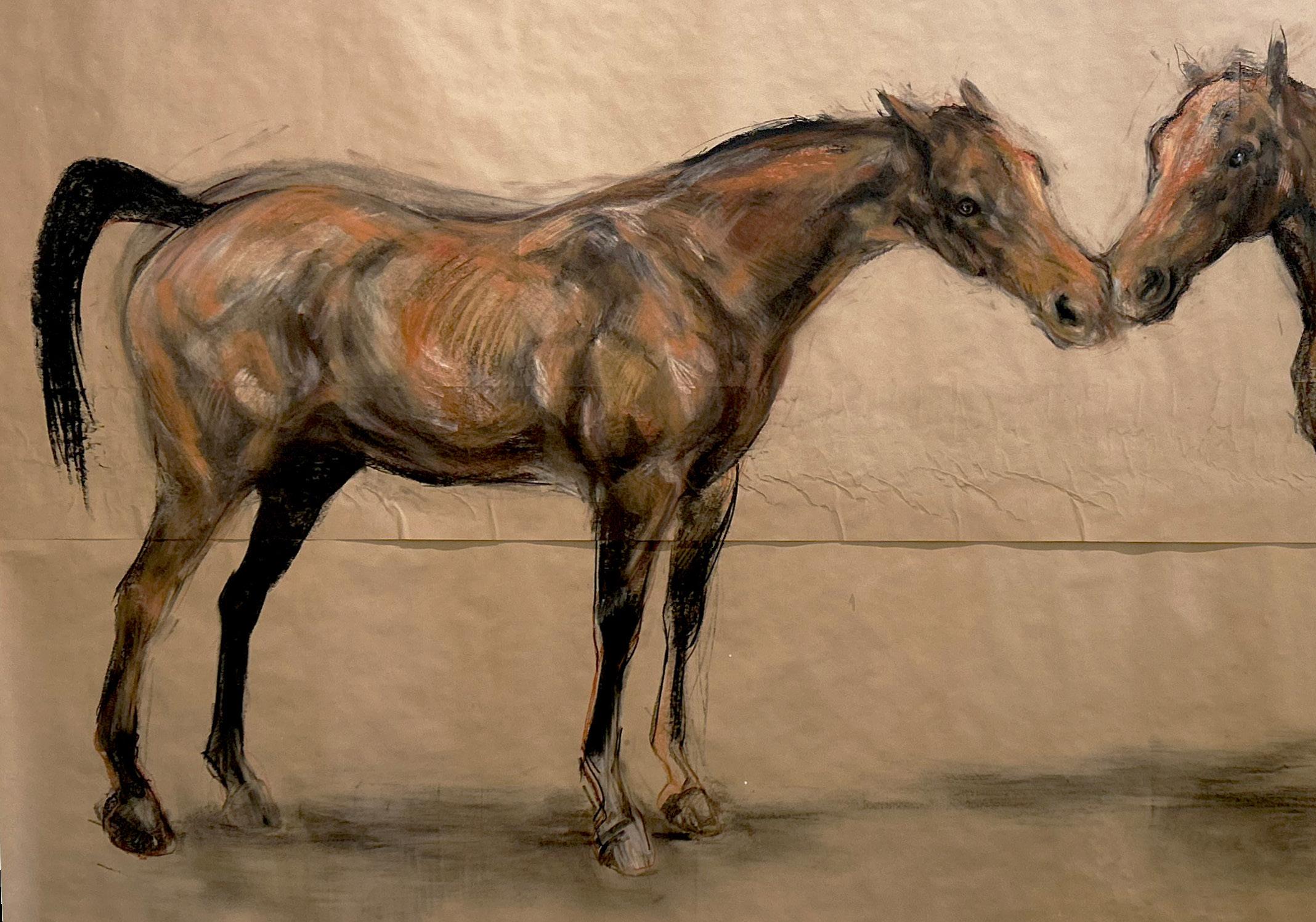



Charcoal on paper
45 1/4 x 64 1/4 inches

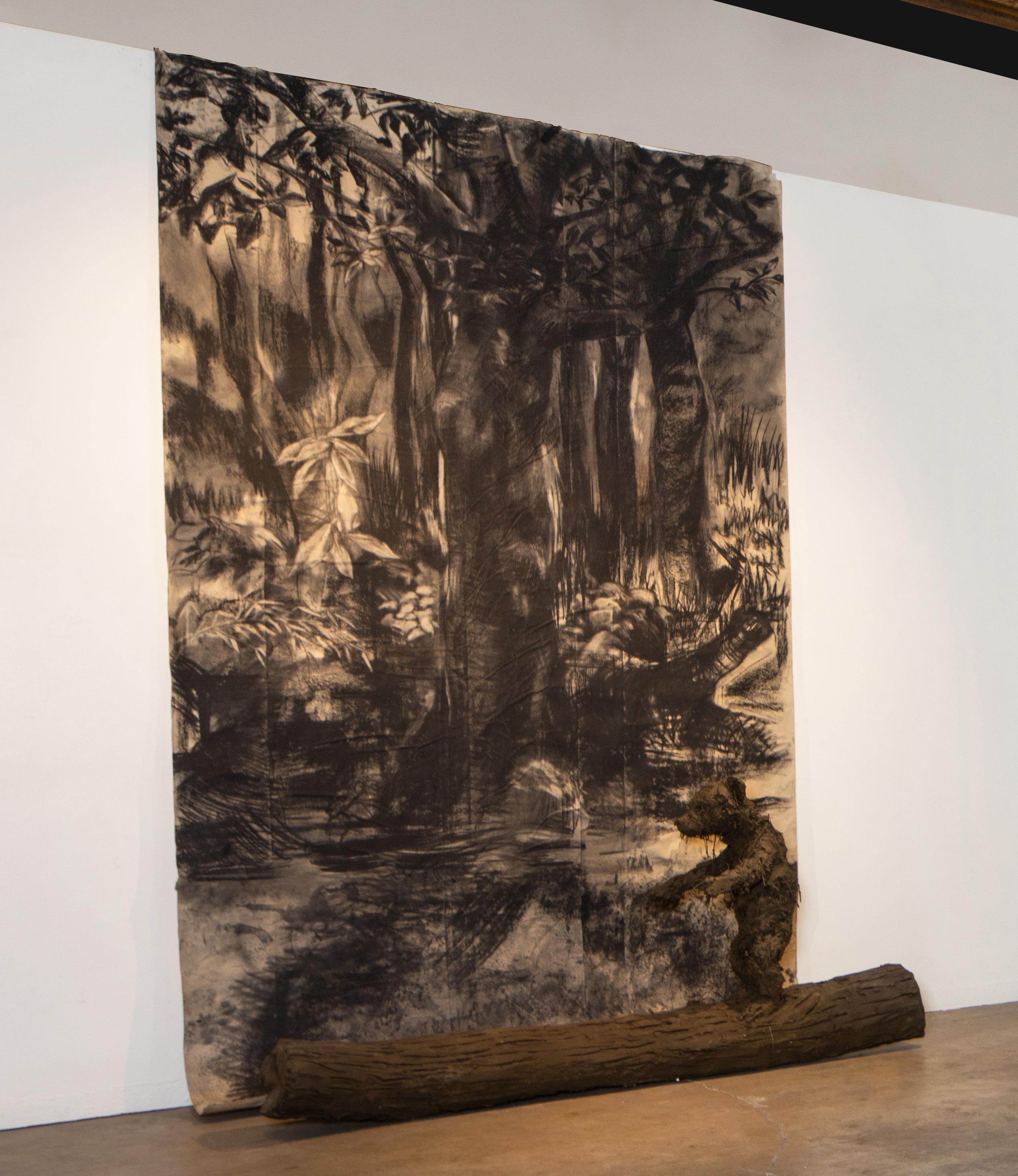



MOUNTAIN LION , 2023
Charcoal and pencil on paper
45 x 59 inches

Charcoal and pencil on paper
45 x 59 inches


“I do my best, all day, every day, to be watchful and open. I lie in bed and look at the ceiling and follow different patterns and shapes in the blotches. I fiddle with shapes and ideas all the time. I draw every day and would go mad if I wasn’t allowed to...It all goes back to being the watchful alien. I really do believe that ninety percent of skill in art is to do with recognition, in recognizing the moment and in knowing when to stop. There can be something about a single line or a simple gesture that says more about a feeling or a body than you could plan in a million years.”
- Nicola HicksCharcoal and pencil on paper
45 x 59 inches

Charcoal and pencil on paper
45 x 59 inches
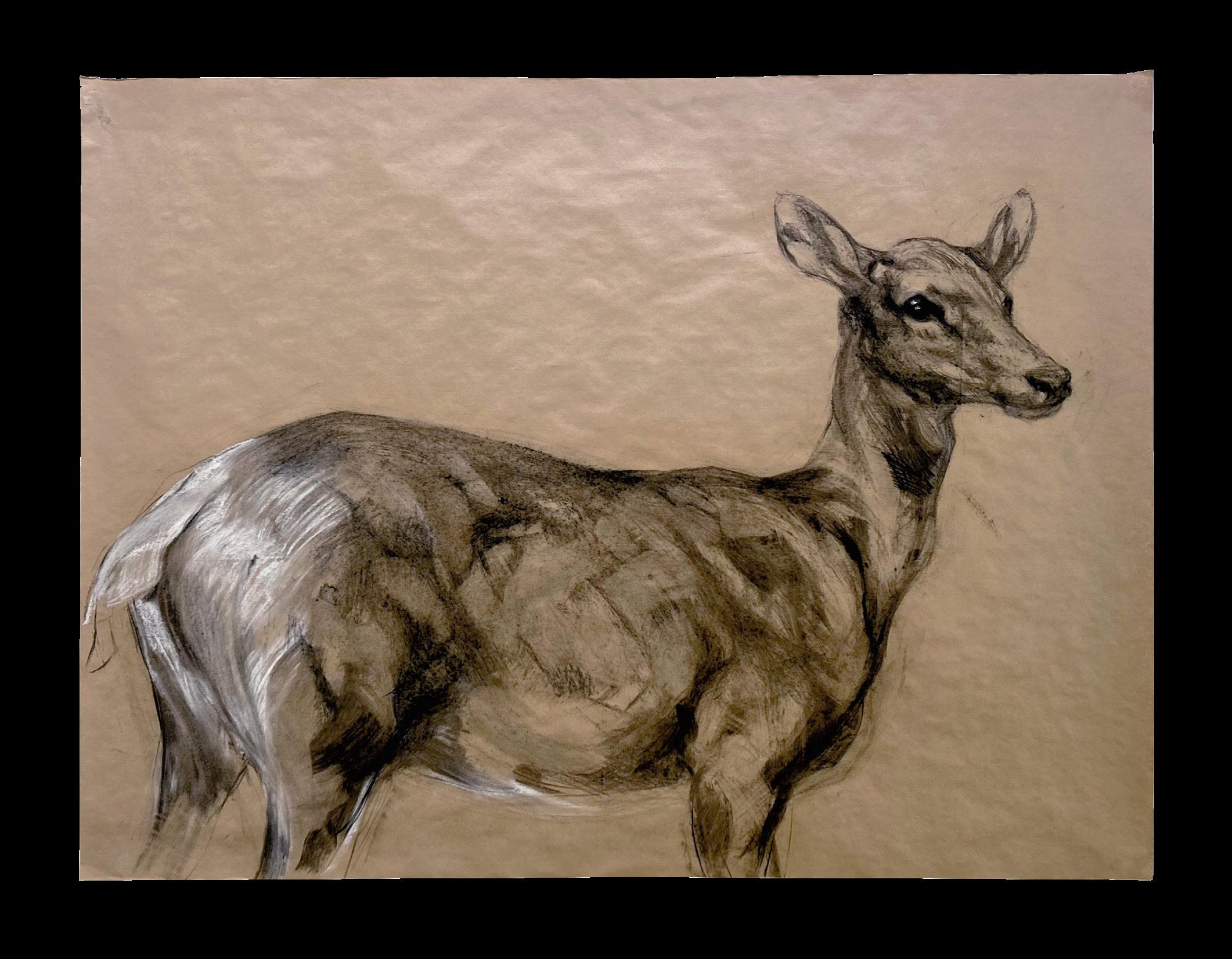



LEMON FOX HOUNDS , 2023
Charcoal and pencil on paper
45 x 59 inches

CIRCLE
Charcoal and pencil on paper
67 x 45 1/2 inches
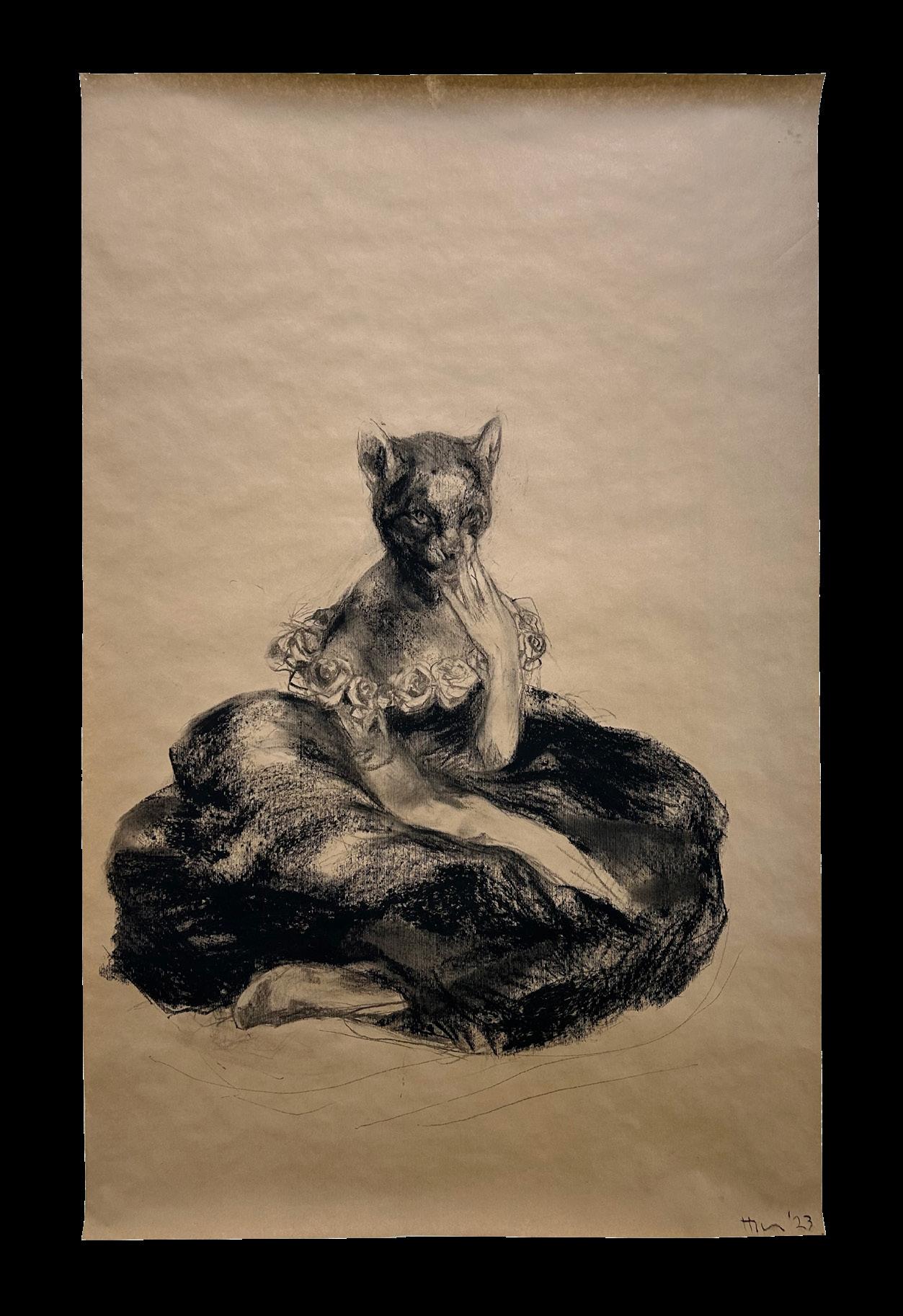





Perhaps it was the middle of January in the present year that I first looked up and saw the mark on the wall. In order to fix a date it is necessary to remember what one saw. So now I think of the fire; the steady film of yellow light upon the page of my book; the three chrysanthemums in the round glass bowl on the mantelpiece. Yes, it must have been the winter time, and we had just finished our tea, for I remember that I was smoking a cigarette when I looked up and saw the mark on the wall for the first time. I looked up through the smoke of my cigarette and my eye lodged for a moment upon the burning coals, and that old fancy of the crimson flag flapping from the castle tower came into my mind, and I thought of the cavalcade of red knights riding up the side of the black rock. Rather to my relief the sight of the mark interrupted the fancy, for it is an old fancy, an automatic fancy, made as a child perhaps. The mark was a small round mark, black upon the white wall, about six or seven inches above the mantelpiece.
lifting it a little way, as ants carry a blade of straw so feverishly, and then leave it.... If that mark was made by a nail, it can't have been for a picture, it must have been for a miniature–the miniature of a lady with white powdered curls, powder-dusted cheeks, and lips like red carnations. A fraud of course, for the people who had this house before us would have chosen pictures in that way–an old picture for an old room. That is the sort of people they were–very interesting people, and I think of them so often, in such queer places, because one will never see them again, never know what happened next. They wanted to leave this house because they wanted to change their style of furniture, so he said, and he was in process of saying that in his opinion art should have ideas behind it when we were torn asunder, as one is torn from the old lady about to pour out tea and the young man about to hit the tennis ball in the back garden of the suburban villa as one rushes past in the train.
How readily our thoughts swarm upon a new object,
But as for that mark, I'm not sure about it; I don't believe it was made by a nail after all; it's too big, too
round, for that. I might get up, but if I got up and looked at it, ten to one I shouldn't be able to say for certain; because once a thing's done, no one ever knows how it happened. Oh! dear me, the mystery of life; The inaccuracy of thought! The ignorance of humanity! To show how very little control of our possessions we have–what an accidental affair this living is after all our civilization–let me just count over a few of the things lost in one lifetime, beginning, for that seems always the most mysterious of losses–what cat would gnaw, what rat would nibble–three pale blue canisters of book-binding tools? Then there were the bird cages, the iron hoops, the steel skates, the Queen Anne coalscuttle, the bagatelle board, the hand organ–all gone, and jewels, too. Opals and emeralds, they lie about the roots of turnips. What a scraping paring affair it is to be sure! The wonder is that I've any clothes on my back, that I sit surrounded by solid furniture at this moment. Why, if one wants to compare life to anything, one must liken it to being blown through the Tube at fifty miles an hour–landing at the other end without a single hairpin in one's hair! Shot out at the feet of
God entirely naked! Tumbling head over heels in the asphodel meadows like brown paper parcels pitched down a shoot in the post office! With one's hair flying back like the tail of a race-horse. Yes, that seems to express the rapidity of life, the perpetual waste and repair; all so casual, all so haphazard....
But after life. The slow pulling down of thick green stalks so that the cup of the flower, as it turns over, deluges one with purple and red light. Why, after all, should one not be born there as one is born here, helpless, speechless, unable to focus one's eyesight, groping at the roots of the grass, at the toes of the Giants? As for saying which are trees, and which are men and women, or whether there are such things, that one won't be in a condition to do for fifty years or so. There will be nothing but spaces of light and dark, intersected by thick stalks, and rather higher up perhaps, rose-shaped blots of an indistinct colour–dim pinks and blues–which will, as time goes on, become more definite, become–I don't know what....
And yet that mark on the wall is not a hole at all. It may even be caused by some round black substance, such as a small rose leaf, left over from the summer, and I, not being a very vigilant housekeeper–look at the dust on the mantelpiece, for example, the dust which, so they say, buried Troy three times over, only fragments of pots utterly refusing annihilation, as one can believe.
The tree outside the window taps very gently on the pane.... I want to think quietly, calmly, spaciously, never to be interrupted, never to have to rise from my chair, to slip easily from one thing to another, without any sense of hostility, or obstacle. I want to sink deeper and deeper, away from the surface, with its hard separate facts. To steady myself, let me catch hold of the first idea that passes.... Shakespeare.... Well, he will do as well as another. A man who sat himself solidly in an arm-chair, and looked into the fire, so–A shower of ideas fell perpetually from some very high Heaven down through his mind. He leant his forehead on his hand, and people, looking in through the open door,–for this scene is supposed to take place on a
summer's evening–But how dull this is, this historical fiction! It doesn't interest me at all. I wish I could hit upon a pleasant track of thought, a track indirectly reflecting credit upon myself, for those are the pleasantest thoughts, and very frequent even in the minds of modest mouse-coloured people, who believe genuinely that they dislike to hear their own praises. They are not thoughts directly praising oneself; that is the beauty of them; they are thoughts like this:
"And then I came into the room. They were discussing botany. I said how I'd seen a flower growing on a dust heap on the site of an old house in Kingsway. The seed, I said, must have been sown in the reign of Charles the First. What flowers grew in the reign of Charles the First?" I asked–(but I don't remember the answer). Tall flowers with purple tassels to them perhaps. And so it goes on. All the time I'm dressing up the figure of myself in my own mind, lovingly, stealthily, not openly adoring it, for if I did that, I should catch myself out, and stretch my hand at once for a book in self-protection. Indeed, it is curious how instinctively one protects the
image of oneself from idolatry or any other handling that could make it ridiculous, or too unlike the original to be believed in any longer. Or is it not so very curious after all? It is a matter of great importance. Suppose the looking glass smashes, the image disappears, and the romantic figure with the green of forest depths all about it is there no longer, but only that shell of a person which is seen by other people–what an airless, shallow, bald, prominent world it becomes! A world not to be lived in. As we face each other in omnibuses and underground railways we are looking into the mirror; that accounts for the vagueness, the gleam of glassiness, in our eyes. And the novelists in future will realize more and more the importance of these reflections, for of course there is not one reflection but an almost infinite number; those are the depths they will explore, those the phantoms they will pursue, leaving the description of reality more and more out of their stories, taking a knowledge of it for granted, as the Greeks did and Shakespeare perhaps–but these generalizations are very worthless. The military sound of the word is enough. It recalls leading articles, cabinet
ministers–a whole class of things indeed which as a child one thought the thing itself, the standard thing, the real thing, from which one could not depart save at the risk of nameless damnation. Generalizations bring back somehow Sunday in London, Sunday afternoon walks, Sunday luncheons, and also ways of speaking of the dead, clothes, and habits–like the habit of sitting all together in one room until a certain hour, although nobody liked it. There was a rule for everything. The rule for tablecloths at that particular period was that they should be made of tapestry with little yellow compartments marked upon them, such as you may see in photographs of the carpets in the corridors of the royal palaces. Tablecloths of a different kind were not real tablecloths. How shocking, and yet how wonderful it was to discover that these real things, Sunday luncheons, Sunday walks, country houses, and tablecloths were not entirely real, were indeed half phantoms, and the damnation which visited the disbeliever in them was only a sense of illegitimate freedom. What now takes the place of those things I wonder, those real standard things? Men perhaps,
should you be a woman; the masculine point of view which governs our lives, which sets the standard, which establishes Whitaker's Table of Precedency, which has become, I suppose, since the war half a phantom to many men and women, which soon, one may hope, will be laughed into the dustbin where the phantoms go, the mahogany sideboards and the Landseer prints, Gods and Devils, Hell and so forth, leaving us all with an intoxicating sense of illegitimate freedom–if freedom exists....
In certain lights that mark on the wall seems actually to project from the wall. Nor is it entirely circular. I cannot be sure, but it seems to cast a perceptible shadow, suggesting that if I ran my finger down that strip of the wall it would, at a certain point, mount and descend a small tumulus, a smooth tumulus like those barrows on the South Downs which are, they say, either tombs or camps. Of the two I should prefer them to be tombs, desiring melancholy like most English people, and finding it natural at the end of a walk to think of the bones stretched beneath the turf.... There
must be some book about it. Some antiquary must have dug up those bones and given them a name.... What sort of a man is an antiquary, I wonder? Retired Colonels for the most part, I daresay, leading parties of aged labourers to the top here, examining clods of earth and stone, and getting into correspondence with the neighbouring clergy, which, being opened at breakfast time, gives them a feeling of importance, and the comparison of arrow-heads necessitates crosscountry journeys to the county towns, an agreeable necessity both to them and to their elderly wives, who wish to make plum jam or to clean out the study, and have every reason for keeping that great question of the camp or the tomb in perpetual suspension, while the Colonel himself feels agreeably philosophic in accumulating evidence on both sides of the question.
It is true that he does finally incline to believe in the camp; and, being opposed, indites a pamphlet which he is about to read at the quarterly meeting of the local society when a stroke lays him low, and his last conscious thoughts are not of wife or child, but of the camp and that arrowhead there, which is now in the
case at the local museum, together with the foot of a Chinese murderess, a handful of Elizabethan nails, a great many Tudor clay pipes, a piece of Roman pottery, and the wine-glass that Nelson drank out of–proving I really don't know what.
No, no, nothing is proved, nothing is known. And if I were to get up at this very moment and ascertain that the mark on the wall is really–what shall we say?–the head of a gigantic old nail, driven in two hundred years ago, which has now, owing to the patient attrition of many generations of housemaids, revealed its head above the coat of paint, and is taking its first view of modern life in the sight of a white-walled fire-lit room, what should I gain?–Knowledge? Matter for further speculation? I can think sitting still as well as standing up. And what is knowledge? What are our learned men save the descendants of witches and hermits who crouched in caves and in woods brewing herbs, interrogating shrew-mice and writing down the language of the stars? And the less we honour them as our superstitions dwindle and our respect for
beauty and health of mind increases.... Yes, one could imagine a very pleasant world. A quiet, spacious world, with the flowers so red and blue in the open fields. A world without professors or specialists or housekeepers with the profiles of policemen, a world which one could slice with one's thought as a fish slices the water with his fin, grazing the stems of the water-lilies, hanging suspended over nests of white sea eggs.... How peaceful it is down here, rooted in the centre of the world and gazing up through the grey waters, with their sudden gleams of light, and their reflections–if it were not for Whitaker's Almanack–if it were not for the Table of Precedency!
I must jump up and see for myself what that mark on the wall really is–a nail, a rose-leaf, a crack in the wood? Here is nature once more at her old game of selfpreservation. This train of thought, she perceives, is threatening mere waste of energy, even some collision with reality, for who will ever be able to lift
a finger against Whitaker's Table of Precedency? The Archbishop of Canterbury is followed by the Lord High Chancellor; the Lord High Chancellor is followed by the Archbishop of York. Everybody follows somebody, such is the philosophy of Whitaker; and the great thing is to know who follows whom. Whitaker knows, and let that, so Nature counsels, comfort you, instead of enraging you; and if you can't be comforted, if you must shatter this hour of peace, think of the mark on the wall.
I understand Nature's game–her prompting to take action as a way of ending any thought that threatens to excite or to pain. Hence, I suppose, comes our slight contempt for men of action–men, we assume, who don't think. Still, there's no harm in putting a full stop to one's disagreeable thoughts by looking at a mark on the wall. Indeed, now that I have fixed my eyes upon it, I feel that I have grasped a plank in the sea; I feel a satisfying sense of reality which at once turns the
two Archbishops and the Lord High Chancellor to the shadows of shades. Here is something definite, something real. Thus, waking from a midnight dream of horror, one hastily turns on the light and lies quiescent, worshipping the chest of drawers, worshipping solidity, worshipping reality, worshipping the impersonal world which is a proof of some existence other than ours. That is what one wants to be sure of.... Wood is a pleasant thing to think about. It comes from a tree; and trees grow, and we don't know how they grow. For years and years they grow, without paying any attention to us, in meadows, in forests, and by the side of rivers–all things one likes to think about. The cows swish their tails beneath them on hot afternoons; they paint rivers so green that when a moorhen dives one expects to see its feathers all green when it comes up again. I like to think of the fish balanced against the stream like flags blown out; and of water-beetles slowly raising domes of mud upon the bed of the river. I like to think of the tree itself: first the close dry sensation of being wood; then the grinding of the storm; then the slow, delicious ooze of sap. I like to think of it,
too, on winter's nights standing in the empty field with all leaves close-furled, nothing tender exposed to the iron bullets of the moon, a naked mast upon an earth that goes tumbling, tumbling, all night long. The song of birds must sound very loud and strange in June; and how cold the feet of insects must feel upon it, as they make laborious progresses up the creases of the bark, or sun themselves upon the thin green awning of the leaves, and look straight in front of them with diamond-cut red eyes.... One by one the fibres snap beneath the immense cold pressure of the earth, then the last storm comes and, falling, the highest branches drive deep into the ground again. Even so, life isn't done with; there are a million patient, watchful lives still for a tree, all over the world, in bedrooms, in ships, on the pavement, lining rooms, where men and women sit after tea, smoking cigarettes. It is full of peaceful thoughts, happy thoughts, this tree. I should like to take each one separately–but something is getting in the way.... Where was I? What has it all been about? A tree?
A river? The Downs? Whitaker's Almanack? The fields of asphodel? I can't remember a thing. Everything's
moving, falling, slipping, vanishing.... There is a vast upheaval of matter. Someone is standing over me and saying–
"I'm going out to buy a newspaper."
"Yes?"
"Though it's no good buying newspapers.... Nothing ever happens. Curse this war; God damn this war!... All the same, I don't see why we should have a snail on our wall."
Ah, the mark on the wall! It was a snail.
"The Mark on the Wall" (1917) by Virginia Woolf (18821941), from: Monday or Tuesday by Virginia Woolf. New York: Harcourt, Brace and Company, Inc., 1921.
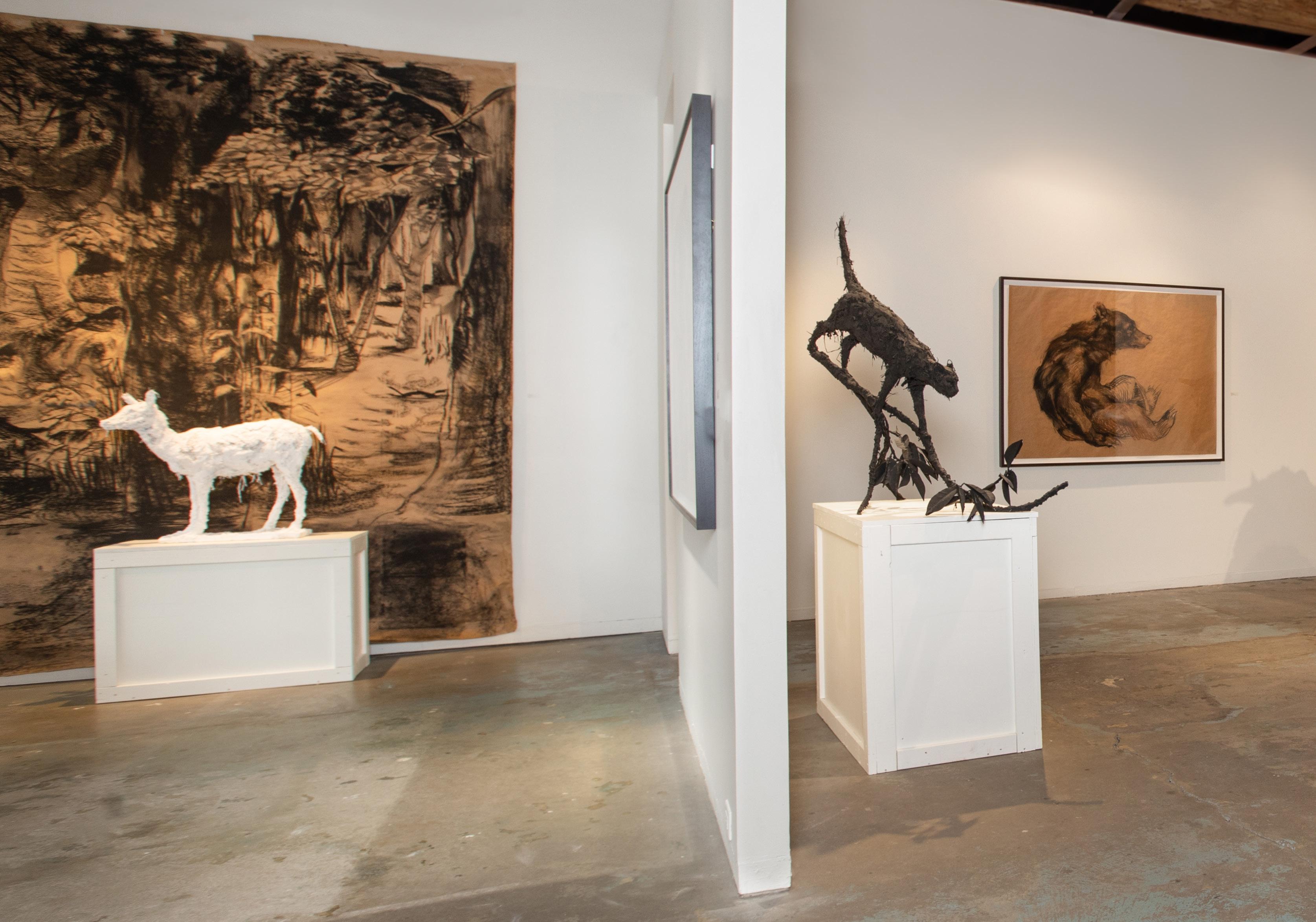
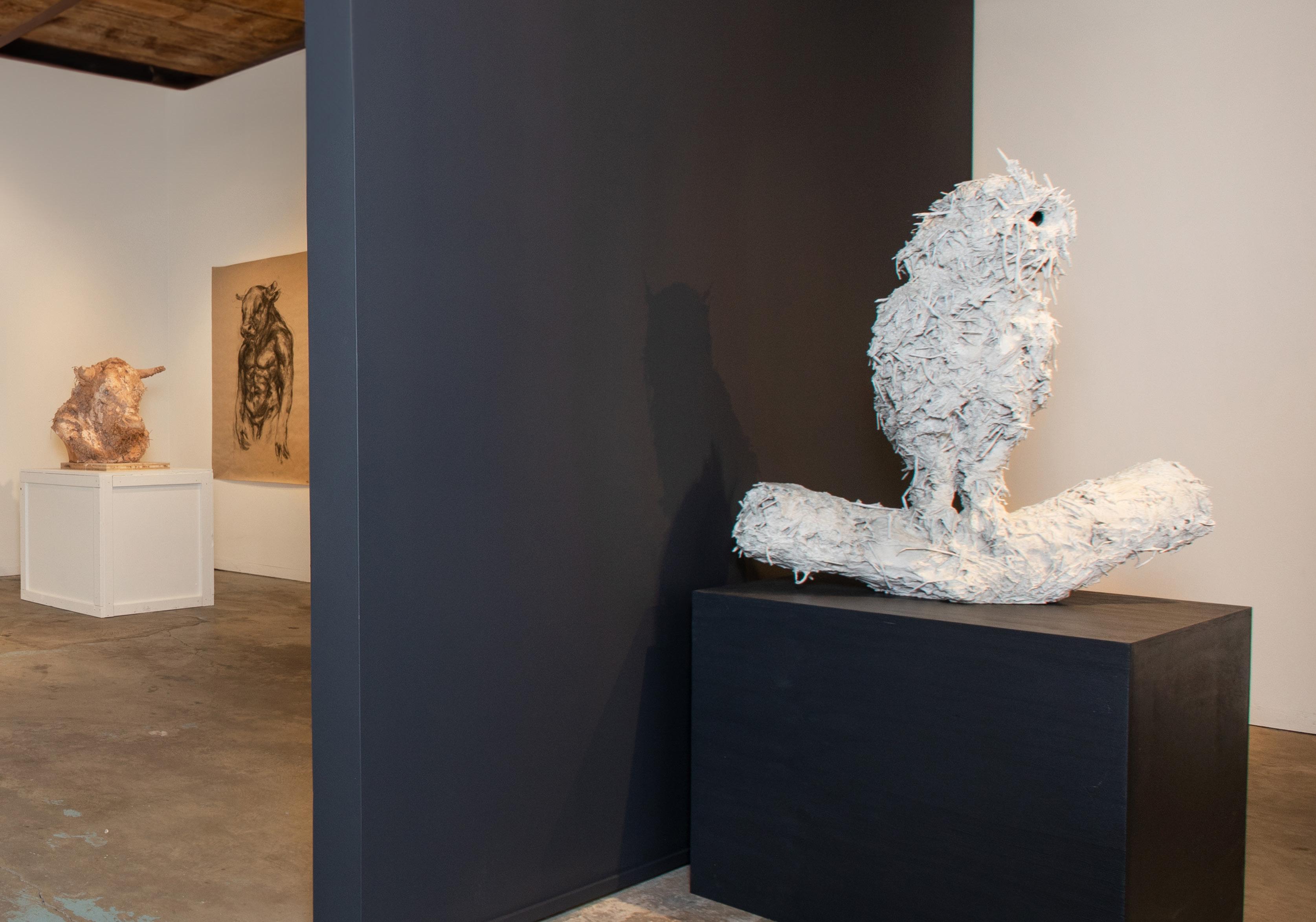
British artist, born in London in 1960
Lives and works in London
1978 - 1982 Chelsea School of Art
1982 - 1985 Royal College of Art
2012 Close Up, Flowers Gallery, Cork Street, London
2011 Aesop’s Fables, Flowers Gallery, Kingsland Road, London
2010 Cliffe Castle Museum Keighley, Bradford
2009 A Walk in the Park, Flowers Gallery Cork Street, London
2008 Circus, Flowers Gallery, Cork Street, Abbott Hall, Kendal
2004 Flowers Gallery, New York
Sculpture at Schoenthal Monastery, Langenbuck, Switzerland
Monuments to Love, Flowers East, London
2003 Sculpture, Drawings and Prints, Flowers & Flowers
Graphics, London
2023 Marks on the Wall, Tayloe Piggott Gallery, Wyoming
2021 Dump Circus, Flowers Gallery, London
2018 Nicola Hicks, Flowers Gallery, New York
Nicola Hicks, Tayloe Piggott Gallery, Wyoming
2017 Wabbling Back to the Fire, Flowers Gallery
Kingsland Road, London
2015 Pause, Flowers Gallery, Cork Street, London
Tayloe Piggott Gallery, Wyoming, USA
2014 Yale Centre for British Art, New Haven, USA
Nicola Hicks, Flowers Gallery, New York
2013 Sorry, Sorry Sarajevo, St Pauls Cathedral, London
New Grafton Gallery, London
Sculpture at Schoenthal Monastery, Langenbuck, Switzerland
Monuments to Love, Flowers East, London
Nicola Hicks, Newby Hall, Yorkshire
2002 Flowers Gallery, Cork Street, London
2001 Flowers West, Santa Monica, California
2000 Nicola Hicks at Newby Hall, Yorkshire
1999 Flowers West, Santa Monica, California, USA
Galerie Rachlin Lemarie-Beaubourg, Paris, France
Outrageous Fortune, Ferens Art Gallery, Hull
Gallery of Modern Art, Glasgow, Scotland
1998 Outrageous Fortune, Flowers East, London
1997 Riverside Studios, London
Galerie de Bellefeuille, Quebec, Canada
Art 28 ‘97, Basel
Belloc Lowndes Fine Art, Chicago, USA
1996 Aberystwyth Arts Centre, Wales
Flowers East at London Fields, London
Furtive Imagination, Whitworth Art Gallery,
Manchester; Yorkshire Sculpture Park, Wakefield
1995 Sculpture and Drawings, Djanogly Art Gallery, University of Nottingham
1994 Flowers East at London Fields, London
1993 Peter Scott Gallery, Lancaster
Castlefield Gallery, Manchester
1992 Flowers East, London
1991 Fire and Brimstone, Flowers East, London; Watermans Art Centre, Brentford
Drawings, Tegnerforbundet, Oslo, Norway
1990 Envelope Drawings and Small Paintings, Flowers
East, London
The Economist, London
1989 Flowers East, London
1988 Flowers East, London
1987 Beaux Arts, Bath
1986 Angela Flowers (Ireland) Inc., Co. Cork
Angela Flowers Gallery, London
1985 Angela Flowers Gallery, London
1984 Artist of the Day, Angela Flowers Gallery, London
2022 Royal Academy Summer Show
Subterranean, Amos Rex, Helsinki, Finland
Forever in the Now, The Lightbox, London
2021 Un/Natural Selections: Wildlife in Contemporary Art, The National Museum of Wildlife Art, Jackson
Hole, Wyoming
2019 Royal Academy Summer Show
Photographs | Contemporary Art: Recent Gifts and Acquisitions, Yale Center for British Art
2018 Push the Boat Out, The Art Academy, London
2016 Pop-Up Exhibition of Flowers Gallery Artists, Nockart Gallery, Hong Kong
2015 Silent Movies Art Exhibition, Q Car Park, Cavendish
Square, London
The British Figure, Flowers Kingsland Road, London
Face to Face, The Baker Museum, Naples, Florida
Arkansas Arts Center, Little Rock, USA
2013 The Universal Addressability of Dumb Things, Hayward Gallery Touring exhibition
Venice Biennale, Italy
The Bluecoat Gallery, Liverpool
Nottingham Contemporary, Nottingham
De La Warr Pavillion, Bexhill on Sea
2012 12 British Artists, Flowers New York, USA
2010 Exhibitionism, The Art of Display, The Courtauld Institute of Art, London
2009 Drawing Inspiration, Abbot Hall Gallery,
2004 Sculpture in the Park, Ayckley Heads, Durham Presence, Lincoln Cathedral, Lincoln
2003 5th Anniversary Exhibition, Flowers West, California Presence, Lincoln Cathedral, Lincoln
2002 Mirror-Mirror, Self Portraits by Women Artists, National Portrait Gallery, London
2000 Holland Park Sculpture Exhibition, London
Wild Tigers of Bandhavgarh, The Burrell Collection, Glasgow, Scotland
1999 The Shape of the Century-100 years of sculpture
in Britain, Salisbury Cathedral
Canary Wharf, London
Animal, Musee Bourdelle, Paris, France
1998 British Figurative Art: Drawings for Sculptures, Galerie Rachlin Lemarié Beaubourg, Paris,
Foundations of Fame, The London Institute
The Body Politic, Wolverhampton Art Gallery
1996 The Hare, The City Gallery, Leicester
1996 The Hare, The City Gallery, Leicester
Hove Museum and Art Gallery
Naked, Flowers East at London Fields, London
Current Issues, Royal College of Art, London
Markovitch Gallery, Miami, USA
Belloc Lowndes Fine Art, Chicago, USA
1995 Atrium Gallery, Coopers & Lybrand, London
25th Anniversary Exhibition, Flowers East at London Fields, London
The Economist Student Summer Exhibitions 19851995, London
Flowers at Koplin, Koplin Gallery, Los Angeles, USA
1994 Dialogue with the Other, Kunsthallen Brandts
Klaedefabrik, Odense, Denmark
Norrkopings Museum, Norrkopings, Sweden
The Downeen Decade, Angela Flowers (Ireland)
Inc., Co. Cork
2nd RWA Open Sculpture Exhibition 1994, Bristol
1993 Fish, Gainsborough's House, Suffolk
Drawing Towards Sculpture, ISIS Gallery and Art
Institute, Leigh-On-Sea
1st RWA Open Sculpture Exhibition 1993, Bristol (Morris Singer Award)
1992 Millfield British 20th Century Sculpture Exhibition, Somerset
1991 Inaugural exhibition, Lannon Cole Gallery, Chicago
Noah's Ark, The Minories Gallery, Colchester
The Downeen Collection, Angela Flowers (Ireland) Inc., Co. Cork
1990 Sculptors' Drawings, Cleveland Bridge Gallery, Bath
The Drawings Show, Thumb Gallery, London
Bryan Kneale's Choice, Dover Street Arts Club,
London
The Discerning Eye, Mall Galleries, London
1989 Angela Flowers Gallery 1970-1990, Concourse
Gallery, Barbican Centre
1988 Hakone Open Air Museum, Japan (British representative)
Veksolund Udstilling for Sculpture, Copenhagen
Out of Clay, Manchester City Art Gallery
1987 Henry Moore Memorial Exhibition, India
Edinburgh Festival Show, The Scottish Gallery, Edinburgh, Scotland
Art in the City, Lloyds Building, London
Cats, Louise Hallett Gallery, London
Process and Product, Turnpike Gallery, Leigh
1986 Works in Clay, Nigel Greenwood Gallery, London
Sixteen, Angela Flowers Gallery, London
The Human Zoo, Castle Museum, Nottingham
The Bretton Menagerie, Yorkshire Sculpture Park, Wakefield
Anti-Thesis, Angela Flowers Gallery, London
1985 Prelude, Kettles Yard, Cambridge
Hayward Annual, Hayward Gallery, London
Economart, Public Art Development Trust, London
The '85 Show, Serpentine Gallery, London
Menagerie, Ramsgate Library
British Art, Printemps, Paris
CAS Market, Smith's Gallery, London
Inaugural Exhibition, Damon Brandt Gallery, New York
1984 International Garden Festival, Liverpool: Sculpture Garden
1983 Portland Clifftops Sculpture Park
Sculptural Drawings, Ruskin College, Oxford
1982 Christie's Inaugural Graduate Exhibition, London
Monument to the Brown Dog, Battersea Park, London
The Contemporary Art Museum St. Louis and the Gateway Foundation, USA
Kentuck Knob, Pennsylvania
Yale Centre for British Art, Connecticut
Arthur Andersen
Brentwood High School, Essex
Castle Museum, Norwich
Chase Manhattan Bank
Chatsworth House, Derbyshire
Contemporary Art Society
Coopers & Lybrand
Djanogly Art Gallery, The University of Nottingham Arts
Centre
Drumcroon Education Centre, Wigan
Government Art Collection
Grand Valley State University Collection
Hakone Open Air Museum
Huddersfield Art Gallery
Ipswich County Council
Tate Gallery
Brentwood High School
Residency at Yorkshire Sculpture Park
Manchester City Art Gallery: Work on site for Out of Clay
New York Academy, New York
Photography by Antonio Parente and Tuck Fauntleroy
Design by Maya Frodeman and Chandler Simpson
Essay by Chandler Simpson
Interview by Patterson Sims
Printed by AlphaGraphics, Idaho Falls, Idaho
